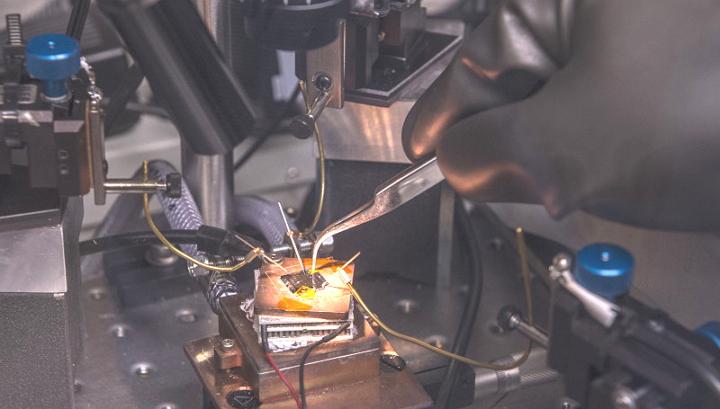A research effort led by Dmitri Talapin, a chemistry professor at the University of Chicago, has demonstrated how semiconductors could be soldered – and even 3D printed — and still deliver the proper electronic performance.
![]() The classical method of manufacturing processes in the silicon industry does not require soldering; instead, engineers create a large silicon crystal which they can cut, carve, and etch to a desired shape.
The classical method of manufacturing processes in the silicon industry does not require soldering; instead, engineers create a large silicon crystal which they can cut, carve, and etch to a desired shape.
And while semiconductor soldering probably won’t have a major impact on mainstream silicon manufacturing technology, it could lead to less expensive, solution-processed semiconductors in markets like those for printable electronics, 3D printing, flat panel display manufacturing, solar cells, and thermoelectric heat-to-electricity generators.
As printable electronics require assembly of semiconductors from discrete pieces via nano-manufacturing, they need to be adhered together. Semiconductors are critical to current electronics devices, and from computer chips to solar cells, materials capable of conducting electricity and generating or controlling electrical current are crucial pieces of the puzzle.
Talapin says he and his associates developed the new solder material to join pieces of semiconducting surfaces, and the material doesn’t interfere with processes which are very sensitive to impurities and defects in their structure.
“It’s like what people call additive manufacturing, when you add things and build from pieces,” Talapin says. “If you want to assemble pieces, you need a solder or glue or connectors. We worked out new chemistry for a broad class of compositions relevant to technologically important semiconductors. If you put two pieces of semiconductor next to each other, each joint will be unique, and in most cases, will block transport of charges. You will not be able to make a reasonably good electronic circuit by simply taking different semiconductor pieces and pressing them against each other as you could do with metals.”
The team, which included Talapin, associates from the University of Chicago, Argonne National Laboratory, and the Illinois Institute of Technology, published their findings in a paper entitled “Composition-Matched Molecular ‘Solders’ for Semiconductors” in the journal Science.
 The compounds, composed of cadmium, lead, and bismuth, can be applied as a liquid or paste to join pieces of a semiconductor after heating them to several hundred degrees Celsius.
The compounds, composed of cadmium, lead, and bismuth, can be applied as a liquid or paste to join pieces of a semiconductor after heating them to several hundred degrees Celsius.
“Our paste or our liquid converts cleanly into a material that will be compositionally matched to the bonded parts, and that required development of new chemistry. We had to design special molecules that fulfill this requirement so that they do not contaminate the material,” Talapin says. “We expect it to be used soon by manufacturers who need to join semiconductor parts, but it could also create new markets in the growing semiconductor industry. For example, it would enable 3D printing of semiconductors and create possibilities for new technologies.”
Part of the work relied on the US Department of Energy’s Advanced Photon Source at the Argonne National Laboratory.
Do you know of other materials breakthroughs in 3D printing and additive manufacturing? Let us know in the Semiconductor Solder forum thread on 3DPB.com.
Subscribe to Our Email Newsletter
Stay up-to-date on all the latest news from the 3D printing industry and receive information and offers from third party vendors.
Print Services
Upload your 3D Models and get them printed quickly and efficiently.
You May Also Like
3D Printing News Briefs, August 20, 2025: Tool Steel Alloy, Microstructure Control, & More
Today’s 3D Printing News Briefs is all about materials, from recycled metal replacements and a new high-strength alloy to microstructure control in nickel-based superalloys and more. Read on for all...
Farsoon and Stark Future Push Titanium 3D Printing for Electric Motorbikes
Farsoon and Stark Future have taken a big step in their partnership. The two companies are already doing serial production of functional parts for Stark’s electric motorbikes. However, their new...
EOS & NASA Sign Agreement to Accelerate Space 3D Printing Workforce Development
If there’s one major issue in the manufacturing sector that can be expected to persist well into the future, it’s workforce development. This is especially true in nations like the...
Headmade Uses the Formlabs Fuse1+ to 3D Print Titanium
Headmade lets you take polymer laser powder bed fusion (LPBF) 3D printers and use them to print metal parts. Using what they call Cold Metal Fusion, a metal-doped polymer feedstock...






























